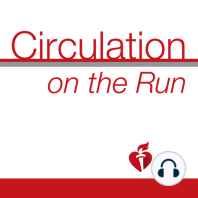17 min listen
Circulation April 24, 2018 Issue
ratings:
Length:
21 minutes
Released:
Apr 24, 2018
Format:
Podcast episode
Description
Dr Carolyn Lam: Welcome to "Circulation On The Run," your weekly podcast summary and backstage pass to the journal and its editors. I'm Dr. Carolyn Lam, Associate Editor, from the National Heart Center, and Duke National University of Singapore. Our featured paper today is so important for cardiac surgeons and their patients. It answers a question of whether targeting a higher versus a lower blood pressure during cardiopulmonary bypass helps to prevent cerebral injury. Curious? Well, more soon right after these summaries. In the first original paper this week, MicroRNA-22 is shown to be a novel mediator of vascular smooth muscle cell, phenotypic modulation, and neointima formation. Co-first authors, Drs. Yang and Chen, co-corresponding authors, Dr. Zhang from Zhejiang University and Dr. Xiao from Queen Mary University of London and their colleagues used wire injury mouse models to show that MicroRNA-22 controls vascular smooth muscle cell phenotype and injury-induced arterial remodeling by modulating multiple target genes, including methyl-CpG-binding protein 2, histone deacetylase 4, and ecotropic virus integration site 1 protein homolog. The authors observed that MicroRNA-22 expression was suppressed in human femoral arteries with atherosclerotic plaques, and that there was an inverse relationship between MicroRNA-22 and its target genes in healthy and diseased arteries. Furthermore, local delivery of MicroRNA-2 in the injured arteries prevented adverse arterial remodeling, thus suggesting that site-specific delivery of MicroRNA-22 mimics may be a potential therapy for in-stent restenosis. The next paper adds to our understanding of the pathobiology of pulmonary hypertension related to left-sided heart failure and importantly adds histomorphometric evidence from human lung specimens at autopsy or surgery. First author Dr. Fayyaz, corresponding author Dr. Redfield, and colleagues from the Mayo Clinic studied patients with heart failure with preserved or reduced ejection fraction and pulmonary hypertension and compared these to normal controls, as well as patients with primary pulmonary veno-occlusive disease. They found that patients with heart failure and pulmonary hypertension had global pulmonary vascular remodeling with thickening of the media and intima in arteries and thickening of the intima in veins and small pulmonary vessels compared to normal control subjects. This venous and small-vessel intimal thickening was more severe than the arterial intimal thickening in heart failure with a pattern that was similar to patients with pulmonary veno-occlusive disease. In fact, the severity of pulmonary hypertension correlated most strongly with venous and small vessel remodeling rather than arterial remodeling. These findings expand our understanding of the pathobiology of pulmonary hypertension in heart failure. It also suggests that pulmonary venous remodeling in heart failure may predispose to worsening alveolar edema with pulmonary vasodilators as in primary pulmonary veno-occlusive diseases. Are there sex and race differences in the lifetime risk of HFpEF versus HFrEF? First author Dr. Pandey, corresponding author Dr. Berry from UT Southwestern Medical Center, and their colleagues used participant level data from two large respective cohort studies, the Cardiovascular Health Study, and the Multi-Ethnic Study of Atherosclerosis to determine remaining lifetime risk estimates for heart failure with preserved and reduced ejection fraction at different index ages. They found tha
Released:
Apr 24, 2018
Format:
Podcast episode
Titles in the series (100)
Circulation January 24, 2017 Issue: Circulation Weekly: Your Weekly Summary & Backstage Pass To The Journal by Circulation on the Run
